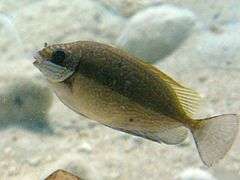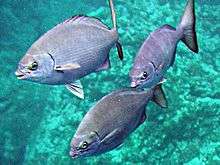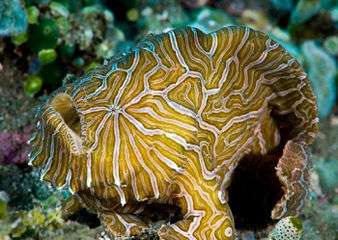Hallucinogenic fish

Sarpa salpa, a species of sea bream, is commonly claimed to be hallucinogenic.[1] These widely distributed coastal fish are normally found in the Mediterranean and around Spain, and along the west and south coasts of Africa.[2] Occasionally they are found in British waters.[3] They can induce LSD-like hallucinations if eaten.[4] In 2006, two men who apparently ate the fish experienced hallucinations lasting for several days.[5][6] The likelihood of hallucinations depends on the season.[7][8][9] Sarpa salpa is known as "the fish that makes dreams" in Arabic.[5]
Other species commonly claimed to be capable of producing hallucinations include several species of sea chub from the genus Kyphosus.[5] It is unclear whether the toxins are produced by the fish themselves or by marine algae in their diet. Other hallucinogenic fish are Siganus spinus,[10] called "the fish that inebriates" in Reunion Island, and Mulloides flavolineatus (formerly Mulloidichthys samoensis),[11] called "the chief of ghosts" in Hawaii.[12]
Cause of hallucinations

The active agent(s) that cause hallucinations in humans, and the origin of these agents, are not clear. Some authors think they could come from toxins associated with macroalgae that accumulate in the flesh of the fish. Toxins from the green algae Caulerpa prolifera in the Mediterranean Sea appear to be implicated,[13] as is the seagrass Posidonia oceanica.[7] When herbivores eat seagrass leaves they ingest algal epiphytes and toxic dinoflagellates that live on the seagrass leaves.[14] The German anthropologist Christian Rätsch thinks that dreamfish might contain the hallucinogen DMT.[15]
"A few reporters have eaten the dream fish and described their strange effects. The most famous user is Joe Roberts, a photographer for the National Geographic magazine. He broiled the dream fish in 1960. After eating the delicacy, he experienced intense hallucinations with a science-fiction theme that included futuristic vehicles, images of space exploration, and monuments marking humanity's first trips into space."[15]
Hallucinogenic species
| Fish species reported as hallucinogenic | ||||||||
|---|---|---|---|---|---|---|---|---|
| Diet | Family | Image | Species | Common name | Max length | Reported locations[5] | Notes | Other sources |
| Herbivores | Clown and damselfishes |  |
Abudefduf septemfasciatus | Banded sergeant | 23 cm |
Gilbert Islands[16] | [17][18] | |
| Rabbitfish |  |
Siganus argenteus | Streamlined spinefoot | 40 cm |
Mauritius[19] | [20][21] | ||
 |
Siganus corallinus | Blue-spotted spinefoot | 35 cm |
Mauritius[19] | [22][23] | |||
 |
Siganus luridus | Dusky spinefoot | 30 cm |
Israel[24][25] | [26][27] | |||
 |
Siganus rivulatus | Marbled spinefoot | 27 cm |
Mauritius[19] Israel (suspected)[28] |
[29][30] | |||
 |
Siganus spinus | Little spinefoot | 28 cm |
Réunion island[31] | [10][32] | |||
| Sea breams |  |
Sarpa salpa | Salema | 51 cm |
Tunisia[33] France[34] Israel[28][35] |
[2][36] | ||
| Sea chub | |
Kyphosus cinerascens | Blue sea chub | 50 cm |
Hawaii[37] | [38][39] | ||
 |
Kyphosus vaigiensis | Brassy chub | 70 cm |
Hawaii[37] | [40][41] | |||
 |
Kyphosus bigibbus | Brown chub | 75 cm |
Norfolk Island[42] | Formerly Kyphosus fuscus | [43][44] | ||
| Surgeon fish |  |
Acanthurus triostegus | Convict surgeonfish | 27 cm |
Hawaii[37] | [45][46] | ||
| Omnivores | Goatfish | |
Mulloides flavolineatus | Yellowstripe goatfish | 43 cm |
Hawaii[47][48][49] | Formerly Mulloidichthys samoensis.[50] Called "the chief of ghosts" in Hawaii[12][51] |
[11][52] |
| |
Upeneus taeniopterus | Finstripe goatfish | 33 cm |
Hawaii[47][48][49] | Formerly Upeneus arge | [53][54] | ||
| Mullet | |
Mugil cephalus | Flathead grey mullet | 100 cm |
Hawaii[47] | [55][56] | ||
| |
Neomyxus leuciscus | Acute-jawed mullet | 46 cm |
Hawaii[47] | Formerly Neomyxus chaptalli | [57][58] | ||
| Carnivores | Groupers | Epinephelus corallicola | Coral grouper | 49 cm |
Gilbert Islands[16] | [59][60] | ||
Ichthyoallyeinotoxism
Ichthyoallyeinotoxism, or hallucinogenic fish inebriation, is a clinical syndrome that refers to a hallucinogenic inebriation of a distressing nature that can arise from consuming hallucinogenic fish. It is characterised by "psychologic disturbances of hallucination and depression. Gastrointestinal disturbance may occur".[61] "Ichthyoallyeinotoxism is a kind of ichthysarcotoxism (fish flesh poisoning) responsible of an unusual clinical feature: it is the unique case of central nervous system ichthyotoxicity. The most frequent signs are dizziness, loss of co-ordination and hallucinations."[13]
Ichthyoallyeinotoxism may result from eating the flesh or the head of the fish where the poison is reputedly concentrated. This biotoxication is sporadic and unpredictable in its occurrence. The poison affects primarily the central nervous system. The symptoms may develop within a few minutes to 2 hours and persist for 24 hours or longer. Symptoms are dizziness, loss of equilibrium, lack of motor coordination, hallucinations and mental depression. A common complaint of the victim is that "someone is sitting on my chest", or there is a sensation of a tight construction around the chest. The conviction that he is going to die, or some other frightening phantasy, is a characteristic part of the clinical picture. Other complaints consist of itching, burning of the throat, muscular weakness and abdominal distress. No fatalities have been reported, and in comparison with other forms of ichthyosarcotoxism, hallucinogenic fish poisoning is relatively mild... Ordinary cooking procedures do not destroy the poison.[62]
Psychedelic fish
Hallucinogenic fish can be contrasted with psychedelic fish. Psychedelic fish do not usually produce hallucinations if eaten, but look as if they were the product of a psychedelic hallucination.[63][64][65]
- ^ Froese, Rainer and Pauly, Daniel, eds. (2013). "Histiophryne psychedelica" in FishBase. October 2013 version.
- ^ Froese, Rainer and Pauly, Daniel, eds. (2013). "Synchiropus picturatus" in FishBase. October 2013 version.
- ^ Froese, Rainer and Pauly, Daniel, eds. (2013). "Synchiropus splendidus" in FishBase. October 2013 version.
See also
References
- ↑ Sarpa Salpa Mahalo
- 1 2 Froese, Rainer and Pauly, Daniel, eds. (2013). "Sarpa salpa" in FishBase. October 2013 version.
- ↑ Fish that triggers hallucinations found off British coast The Telegraph, 13 May 2009.
- ↑ 'Hallucination' fish netted in Channel The Guardian, 13 May 2009.
- 1 2 3 4 de Haro, L.; Pommier, P. (2006). "Hallucinatory fish poisoning (ichthyoallyeinotoxism): two case reports from the Western Mediterranean and literature review". Clinical Toxicology (Philadelphia) 44 (2): 185–8. doi:10.1080/15563650500514590. PMID 16615678.
- ↑ Clarke, Matt (19 April 2006). "Men hallucinate after eating fish". Practical Fishkeeping. Retrieved 31 March 2010.
- 1 2 Bellassoued K, A Hamza, A Abdelmouleh, FA Makni, JV Pelt and A Elfeki (2012) "Toxicity assessment of dreamfish Sarpa salpa from the Gulf of Gabes (Tunisia, Eastern Mediterranean Sea)" Journal of Food, Agriculture and Environment, 10 (2): 1308–1313.
- ↑ de Haro L, Jouglard DE, Thomas MJ and David JM (1994) "Intoxications de type ciguatera after eating the Sparidae in Mediterranean". In Boudoresque, CF, Meinsez A and Gravez V. (Eds) First International Workshop on Caulerpa taxifolia GIS Posidonie Publ., France, pp. 271–274. ISBN 9782905540195.
- ↑ Bellassoued K, Hamza A, Abdelmouleh A, Pelt JV and El Feki A (2011) "Antioxidant response in the salema Sarpa salpa: Interseasonal correlations with the diet" J. Food. Agric. Environ., 9 (1): 730–733.
- 1 2 Froese, Rainer and Pauly, Daniel, eds. (2013). "Siganus spinus" in FishBase. October 2013 version.
- 1 2 Froese, Rainer and Pauly, Daniel, eds. (2013). "Mulloides flavolineatus" in FishBase. October 2013 version.
- 1 2 Thomas, Craig, M.D. and, Susan Scott (June 1, 1997). All Stings Considered: First Aid and Medical Treatment of Hawai'i's Marine Injuries. Hawaii: University of Hawai'i Press. p. 120. ISBN 9780824819002.
- 1 2 de Haro, L., Prost, N., Arditti, J., David, J. M., & Jouglard, J. (1998) "Ichthyoallyeinotoxism: a rare pathology" Toxicon, 36 (12): 1738–1739.
- ↑ Kitting CL, Fry B and Morgan MD (1984) "Detection of inconspicuous epiphytic algae supporting food webs in seagrass meadows" Oecologia, 62 :145–149.
- 1 2 Pickover, Clifford A (2005) [ Sex, Drugs, Einstein, and Elves] Chapter 1, page 9, Smart Publications. ISBN 9781890572174.
- 1 2 Cooper MJ (1964) "Ciguatera and other marine poisoning in the Gilbert Islands", Pacific Science, 18 (4): 411–440.
- ↑ Abudefduf septemfasciatus: Sevenband Damselfish Encyclopedia of Life. Retrieved 23 October 2013.
- ↑ Froese, Rainer and Pauly, Daniel, eds. (2013). "Abudefduf septemfasciatus" in FishBase. October 2013 version.
- 1 2 3 Halstead BW, Cox KM (1973) "An investigation on fish poisoning in Mauritius", Proc Roy Soc Arts Sci Mauritius, 4 (2): 1–26.
- ↑ Siganus argenteus: Yellowspotted Spinefoot Encyclopedia of Life. Retrieved 23 October 2013.
- ↑ Froese, Rainer and Pauly, Daniel, eds. (2013). "Siganus argenteus" in FishBase. October 2013 version.
- ↑ Siganus corallinus: Blue-spotted spinefoot Encyclopedia of Life. Retrieved 23 October 2013.
- ↑ Froese, Rainer and Pauly, Daniel, eds. (2013). "Siganus corallinus" in FishBase. October 2013 version.
- ↑ Raikhlin-Eisenkraft B and Bentur Y (2002) "Rabbitfish ("Aras"). An unusual source of ciguatera poisoning" Israeli Medical Association Journal, 4: 28–30.
- ↑ Herzberg A (1973) "Toxicity of Siganus luridus (Ruppell) on the Mediterranean Coast of Israël" Aquaculture, 2: 89–91.
- ↑ Siganus luridus: Squaretail Rabbitfish Encyclopedia of Life. Retrieved 23 October 2013.
- ↑ Froese, Rainer and Pauly, Daniel, eds. (2013). "Siganus luridus" in FishBase. October 2013 version.
- 1 2 Spanier E, Finkelstein Y and Raikhlin-Eisenkraft B (1989) "Toxicity of the saupe, Sarpa salpa (Linnaeus, 1758), on the Mediterranean coast of Israel" Journal of Fish Biology, 34: 635–636. doi:10.1111/j.1095-8649.1989.tb03342.x
- ↑ Siganus rivulatus: Squaretail Rabbitfish Encyclopedia of Life. Retrieved 23 October 2013.
- ↑ Froese, Rainer and Pauly, Daniel, eds. (2013). "Siganus rivulatus" in FishBase. October 2013 version.
- ↑ Lebeau A (1979) "La ciguatera dans l’Océan Indien: étude des poissons vénéneux des bancs de l’archipel des Mascareignes et de la crète centrale de l’Océan Indien Rev Trav Inst Pêches Marit, 42 (4): 325–345.
- ↑ Siganus spinus: Little spinefoot Encyclopedia of Life. Retrieved 23 October 2013.
- ↑ Chevaldonne P (1990) "Ciguatera and the saupe, Sarpa salpa (L.), in the Mediterranean: a possible misinterpretation" Journal of fish biology, 37: 503–504. doi:10.1111/j.1095-8649.1990.tb05883.x
- ↑ de Haro L, Treffot MJ, Jouglard J and Perringué C (1993) "Trois cas d'intoxication de type ciguatérique après ingestion de Sparidae de Méditerranée", Ictyophysiologica Acta, 16: 133–146.
- ↑ Raikhlin-Eisenkraft B, Finkelstein Y, Spanier E (1988) "Ciguatera-like poisoning in the Mediterranean" Vet Hum Toxicol, 30 (6): 582–583.
- ↑ Sarpa salpa: Salema porgy Encyclopedia of Life. Retrieved 23 October 2013.
- 1 2 3 Helfrich P (1963) "Fish Poisoning in Hawaii Hawaii Medical Journal, 22 (5): 361–372.
- ↑ Kyphosus cinerascens: Blue Seachub Encyclopedia of Life. Retrieved 23 October 2013.
- ↑ Froese, Rainer and Pauly, Daniel, eds. (2013). "Kyphosus cinerascens" in FishBase. October 2013 version.
- ↑ Kyphosus vaigiensis: Lowfinned Drummer Encyclopedia of Life. Retrieved 23 October 2013.
- ↑ Froese, Rainer and Pauly, Daniel, eds. (2013). "Kyphosus vaigiensis" in FishBase. October 2013 version.
- ↑ Roughly TC, Roberts BJ (1960) "Bounty descendant live on remote Norfolk Island" National Geographic Magazine, 116 (6): 575.
- ↑ Kyphosus bigibbus: Striped Drummer Encyclopedia of Life. Retrieved 23 October 2013.
- ↑ Froese, Rainer and Pauly, Daniel, eds. (2013). "Kyphosus bigibbus" in FishBase. October 2013 version.
- ↑ Acanthurus triostegus: Convict Tang Encyclopedia of Life. Retrieved 23 October 2013.
- ↑ Froese, Rainer and Pauly, Daniel, eds. (2013). "Acanthurus triostegus" in FishBase. October 2013 version.
- 1 2 3 4 Helfrich P, Banner A. (1960) "Hallucinatory mullet poisoning" Journal of Tropical Medicine and Hygiene, 1: 86–89.
- 1 2 Jordan DS, Evermann BW and Tanaka S (1927) "Notes on new or rare fishes from Hawaii", Proceedings of the California Academy of Science, 16 (20): 649–680.
- 1 2 Randall JE (1958) "A review of ciguatera, tropical fish poisoning, with tentative explanation of its cause", Bulletin of Marine Science Gulf Caribbean, 8 (3): 236–267.
- ↑ Froese, Rainer and Pauly, Daniel, eds. (2009). "Mulloidichthys samoensis" in FishBase. October 2009 version.
- ↑ Titcomb, Margaret (1951) "Memoir: Native use of fish in Hawaii" Journal of the Polynesian Society, 60" 1–146.
- ↑ Mulloides flavolineatus: Yellowstripe goatfish Encyclopedia of Life. Retrieved 23 October 2013.
- ↑ Upeneus arge: Bandtail Goatfish Encyclopedia of Life. Retrieved 23 October 2013.
- ↑ Froese, Rainer and Pauly, Daniel, eds. (2013). "Upeneus taeniopterus" in FishBase. October 2013 version.
- ↑ Mugil cephalus: Striped Mullet Encyclopedia of Life. Retrieved 23 October 2013.
- ↑ Froese, Rainer and Pauly, Daniel, eds. (2013). "Mugil cephalus" in FishBase. October 2013 version.
- ↑ Neomyxus leuciscus: Brown Mullet Encyclopedia of Life. Retrieved 23 October 2013.
- ↑ Froese, Rainer and Pauly, Daniel, eds. (2013). "Neomyxus leuciscus" in FishBase. October 2013 version.
- ↑ Epinephelus corallicola: Malabar Grouper Encyclopedia of Life. Retrieved 23 October 2013.
- ↑ Froese, Rainer and Pauly, Daniel, eds. (2013). "Epinephelus corallicola" in FishBase. October 2013 version.
- ↑ Report of the Seminar on Ichthyosarcotoxism Papeete 1968, South Pacific Commission.
- ↑ R Bagnis R, F Berglund, PS Elias, GJ van Esch, BW Halstead and K Kojima (1970) "Problems of Toxicants in Marine Food Products: 1. Marine biotoxins" Bulletin of the World Health Organisation, 42: 69–88.
- ↑ "Psychedelic" fish picture: New Species Bounces on Reef National Geographic, 25 February 2009.
- ↑ The Psychedelic mandarin Practical fishkeeping, 4 May 2011.
- ↑ Department of Defense (2000) Coral Reef Protection Implementation Plan Diane Publishing. ISBN 9781428911260.
External links
- Dolphins 'getting high' on puffer fish, zoologist Rob Pilley says news.com.au, 30 December 2013.
| |||||||||||||||||||||||||||||||||||||||||||||||||||||||||||



